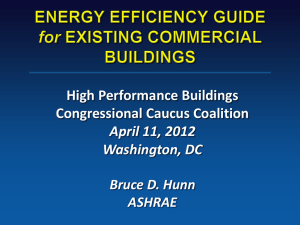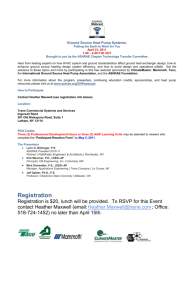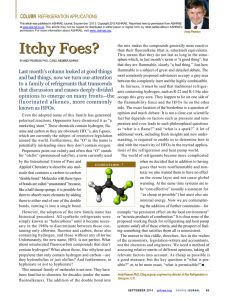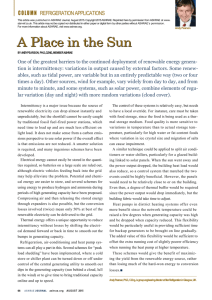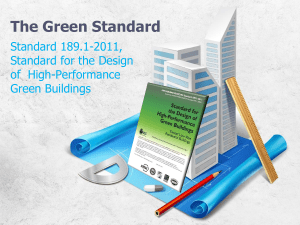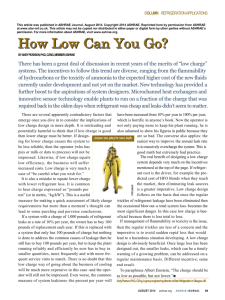ENGINEERING AND C B
advertisement
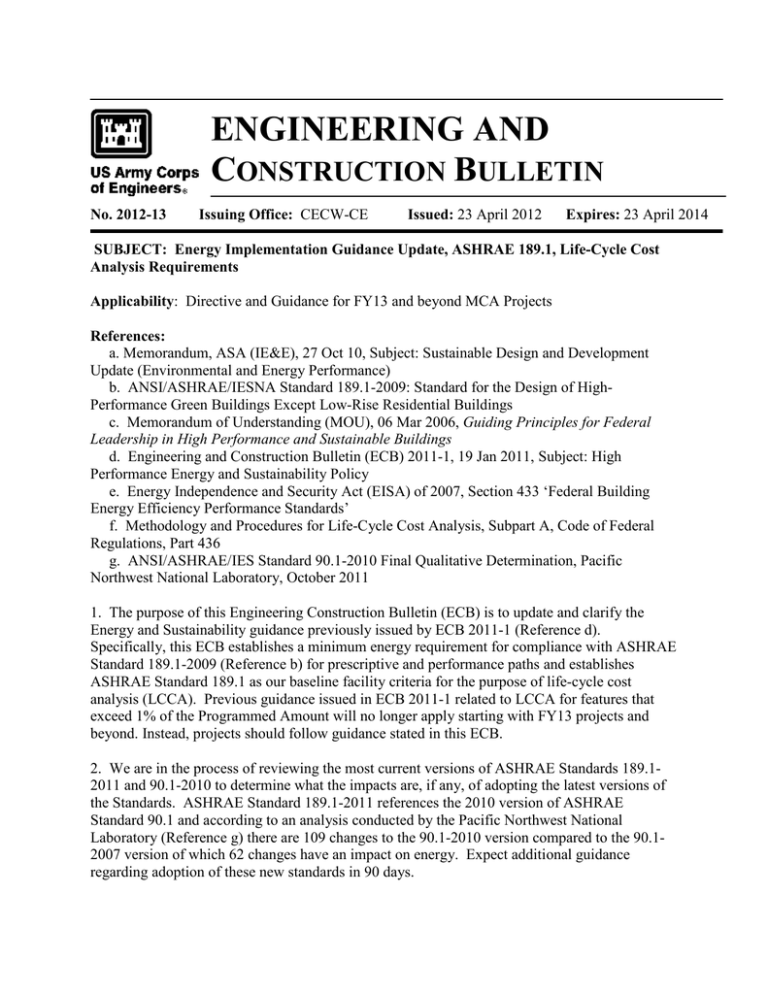
ENGINEERING AND CONSTRUCTION BULLETIN No. 2012-13 Issuing Office: CECW-CE Issued: 23 April 2012 Expires: 23 April 2014 SUBJECT: Energy Implementation Guidance Update, ASHRAE 189.1, Life-Cycle Cost Analysis Requirements Applicability: Directive and Guidance for FY13 and beyond MCA Projects References: a. Memorandum, ASA (IE&E), 27 Oct 10, Subject: Sustainable Design and Development Update (Environmental and Energy Performance) b. ANSI/ASHRAE/IESNA Standard 189.1-2009: Standard for the Design of HighPerformance Green Buildings Except Low-Rise Residential Buildings c. Memorandum of Understanding (MOU), 06 Mar 2006, Guiding Principles for Federal Leadership in High Performance and Sustainable Buildings d. Engineering and Construction Bulletin (ECB) 2011-1, 19 Jan 2011, Subject: High Performance Energy and Sustainability Policy e. Energy Independence and Security Act (EISA) of 2007, Section 433 ‘Federal Building Energy Efficiency Performance Standards’ f. Methodology and Procedures for Life-Cycle Cost Analysis, Subpart A, Code of Federal Regulations, Part 436 g. ANSI/ASHRAE/IES Standard 90.1-2010 Final Qualitative Determination, Pacific Northwest National Laboratory, October 2011 1. The purpose of this Engineering Construction Bulletin (ECB) is to update and clarify the Energy and Sustainability guidance previously issued by ECB 2011-1 (Reference d). Specifically, this ECB establishes a minimum energy requirement for compliance with ASHRAE Standard 189.1-2009 (Reference b) for prescriptive and performance paths and establishes ASHRAE Standard 189.1 as our baseline facility criteria for the purpose of life-cycle cost analysis (LCCA). Previous guidance issued in ECB 2011-1 related to LCCA for features that exceed 1% of the Programmed Amount will no longer apply starting with FY13 projects and beyond. Instead, projects should follow guidance stated in this ECB. 2. We are in the process of reviewing the most current versions of ASHRAE Standards 189.12011 and 90.1-2010 to determine what the impacts are, if any, of adopting the latest versions of the Standards. ASHRAE Standard 189.1-2011 references the 2010 version of ASHRAE Standard 90.1 and according to an analysis conducted by the Pacific Northwest National Laboratory (Reference g) there are 109 changes to the 90.1-2010 version compared to the 90.12007 version of which 62 changes have an impact on energy. Expect additional guidance regarding adoption of these new standards in 90 days. No. 2012-13 SUBJECT: Energy Implementation Guidance Update, ASHRAE 189.1, Life-Cycle Cost Analysis Requirements 3. As stated in ECB 2011-1 (Reference d), all FY13 and beyond projects are required to meet the Energy and Sustainability requirements of ASHRAE Standard 189.1 according to Department of the Army Sustainable Design and Development Policy Update (Reference a) with the noted exemptions. The Army established ASHRAE Standard 189.1 as a minimum standard and recognizes that Congressional Law and Executive Orders drive project solutions beyond the requirements of ASHRAE Standard 189.1; an example being EISA 2007 fossil fuel reduction targets (Reference e). 4. Per Army Policy, ASHRAE 189.1 is a minimum requirement and shall be used as the project baseline for life-cycle cost comparisons. A LCCA is not required on the baseline project. An incremental LCCA shall be completed for all energy efficiency or conservation features provided in excess of the baseline to ensure the payback period is no greater than the lesser of 40 years or the projected life of the facility. Equipment procurement, fuel, maintenance, repair, replacement, and any other quantifiable benefits and costs are to be included in the LCCA. The LCCA will be documented and made part of the design analysis. 5. When applying ASHRAE Standard 189.1 energy performance standards, ensure that the minimum energy savings to be achieved, through performance or prescriptive paths, is at least 30 percent better than ASHRAE Standard 90.1-2007 (including process and plug loads). This 30 percent savings threshold may in some cases be a slight improvement upon the standard for certain facility types in some climatic zones. 6. 10 CFR Part 436 (Reference f) establishes a methodology to conduct a LCCA for determining energy and water conservation improvements for Federal Buildings. The Building Life-Cycle Cost (BLCC) program developed by the National Institute of Standards and Technology (NIST) was designed to comply with 10 CFR Part 436 and includes a MILCON Analysis module. All project delivery teams shall use the BLCC program and follow the methodology in 10 CFR Part 436 to determine the LCCA for each project when requesting additional funds for features in excess of the baseline described in Paragraph 3. A link is provided below with instructions on how to download the BLCC program for free: http://www1.eere.energy.gov/femp/information/download_blcc.html 7. A request for an exemption to HQUSACE may be made for any specific requirement included herein or by reference that the PDT determines would adversely affect mission performance, security requirements, health, safety, or welfare. The request for exemption shall only apply to the specific requirements in conflict. Any approved exemptions to the guidance shall be documented with reference to the specific requirement in conflict and included in the project documentation. 2 No. 2012-13 SUBJECT: Energy Implementation Guidance Update, ASHRAE 189.1, Life-Cycle Cost Analysis Requirements 8. The HQUSACE points of contact for this ECB are Mr. George O. Lea JR, CECW-CE, 202761-7775 or george.o.lea@usace.army.mil and Mr. Daniel Carpio, CECW-CE, 202-761-4227 or Daniel.Carpio@usace.army.mil. //S// LLOYD C. CALDWELL, P.E. Chief , Programs Integration Division Directorate of Military Programs //S// JAMES C. DALTON, P.E., SES Chief, Engineering and Construction Directorate of Civil Works 3

